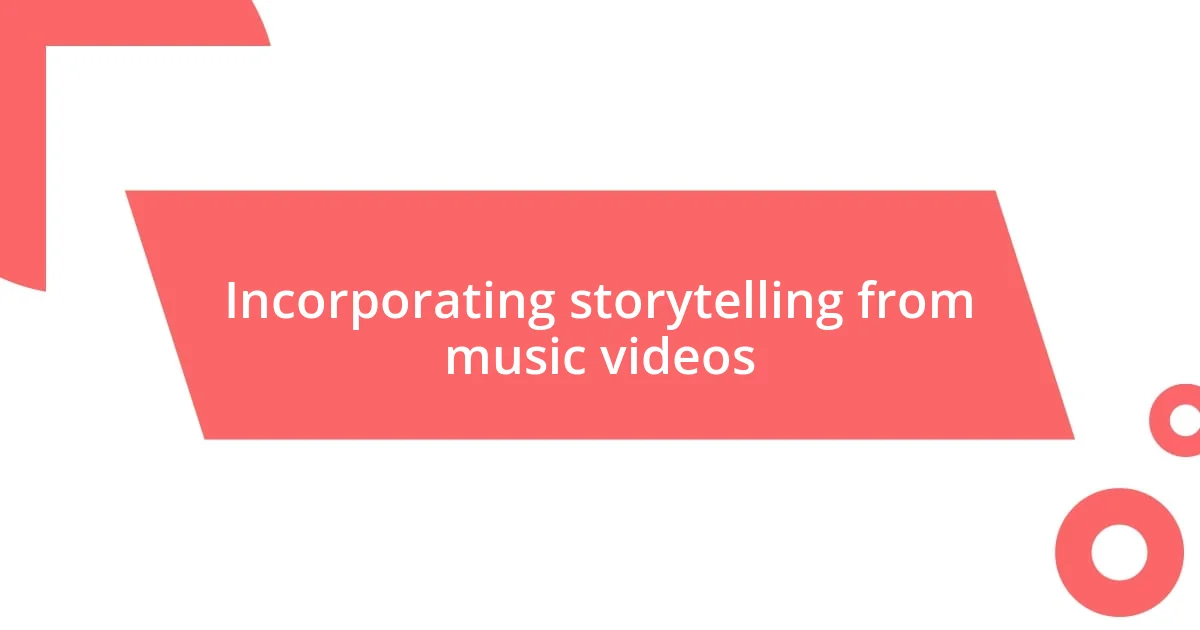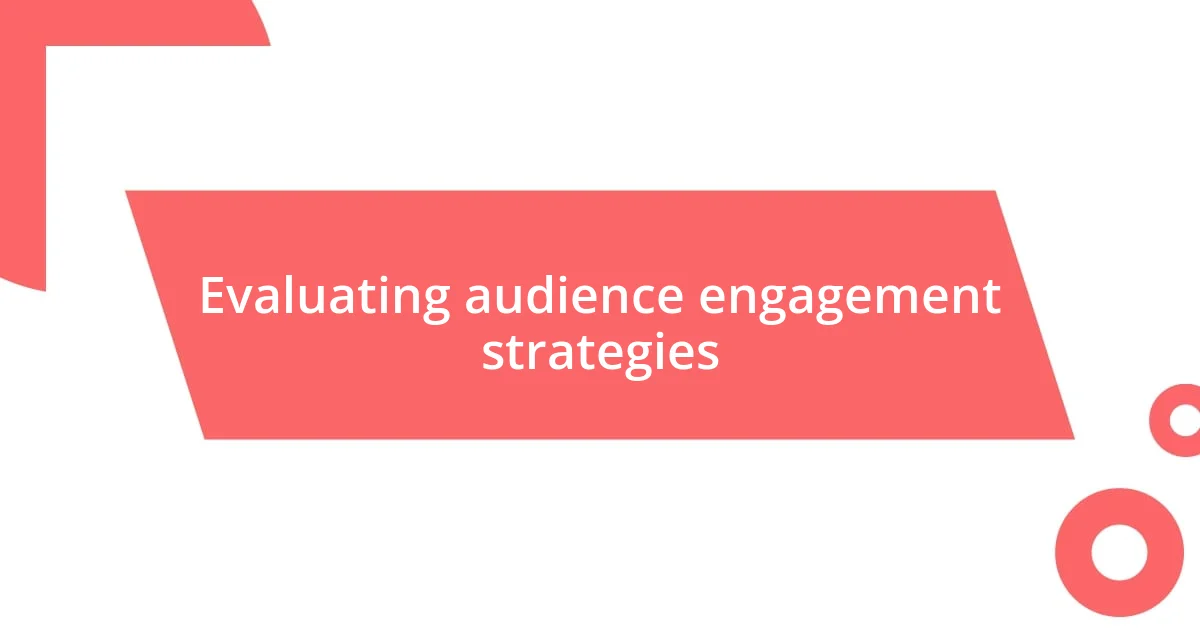Key takeaways:
- Successful music videos amplify song messages through striking visuals, storytelling, and elements of surprise, creating lasting emotional connections with viewers.
- Adapting visual aesthetics across different mediums requires authenticity to the original message while employing tailored strategies, such as dynamic colors for social media and immersive lighting for live performances.
- Effective audience engagement techniques include fostering dialogue through viewer questions, incorporating feedback loops, and utilizing vibrant visuals to create active, emotional connections with the audience.

Analyzing successful music video concepts
When I think about successful music video concepts, I’m often reminded of how visuals can amplify a song’s message. For instance, the use of striking imagery in a video not only captivates the audience but also creates a deeper emotional connection. Have you ever found yourself mesmerized by a powerful visual scene that stuck with you long after the music faded? I know I have.
A standout example is the use of storytelling in videos, which can transform a song into a cinematic experience. I’ve noticed artists who weave narratives throughout their videos often leave a lasting impression on viewers. It’s a technique I’ve tried to apply in my own creative projects, as I believe that telling a compelling story alongside a great song creates a unique synergy. How can you capture your audience’s attention if your visuals don’t resonate with the music?
Furthermore, I think the element of surprise plays a crucial role in the success of music videos. I still remember the first time I watched a video that completely veered away from what I expected. It felt fresh and invigorating, pushing the boundaries of creativity. This notion inspires me to think outside the box when conceptualizing my projects. What surprises can elevate your vision and differentiate you from others?

Adapting visuals for different mediums
Adapting visuals for different mediums requires a thoughtful approach. I’ve found that translating music video aesthetics into other forms, like social media content, can be a rewarding challenge. For instance, using bold colors and dynamic movement can create a similar energy on platforms like Instagram or TikTok, instantly drawing viewers in. Have you noticed how some creators leverage quick cuts and vibrant visuals to hold our attention in just a few seconds? It’s fascinating!
Another aspect I enjoy is how different mediums demand varying techniques while maintaining the core message. When I adapted a music video concept for a live performance piece, I emphasized visual storytelling through lighting and choreography. This not only encapsulated the essence of the song but also engaged the audience on an emotional level. Can you think of a time when visuals enhanced a live experience? I certainly believe that immersive elements can transform how we perceive a performance.
Additionally, I realize that when transitioning visuals between mediums, it’s crucial to stay authentic to the original message. While I was creating content for a blog, I took inspiration from a music video’s art direction. The imagery I used resonated with my readers, making the written content more relatable and memorable. This adaptability not only broadens the reach of your work but also creates a cohesive narrative across platforms.
| Medium | Visual Strategy |
|---|---|
| Music Video | Bold colors, storytelling, surprise elements |
| Social Media | Quick cuts, vibrant visuals, engagement techniques |
| Live Performance | Choreography, immersive lighting, emotional connection |
| Blog Content | Art direction, relatable imagery, cohesive narrative |

Incorporating storytelling from music videos
I’ve always been drawn to the storytelling aspect of music videos, which often resonates with my own experiences in creative storytelling. For instance, there was a time when I watched a music video that beautifully illustrated the journey of love and loss. The way the visuals paired with the lyrics had me reflecting on my own life, sparking memories I hadn’t thought of in years. This emotional connection is something I strive to evoke in my work, as I believe that when a story unfolds visually, it can touch souls and create lasting impressions.
To help incorporate storytelling inspired by music videos, consider these key elements:
- Character Development: Introduce relatable characters to evoke empathy.
- Narrative Arc: Include a beginning, middle, and end to craft a cohesive story.
- Symbolism: Use visual symbols to add depth and layers to your narrative.
- Emotional Beats: Focus on key moments that evoke strong feelings, much like how certain scenes can resonate deeply in a music video.
- Cinematic Techniques: Incorporate elements like slow motion or close-ups to enhance emotional impact.
Incorporating these elements not only enriches your content but also allows you to engage with your audience on a more profound level, much like those captivating music videos that linger in our minds.

Utilizing rhythm and pacing techniques
Utilizing rhythm and pacing techniques is vital in creating impactful visuals. I remember the first time I edited a project where I closely watched how music videos use quick cuts synchronized to the beat. This experience taught me that maintaining a steady rhythm keeps viewers engaged and makes the overall content feel dynamic. Have you ever noticed how a change in tempo can change your emotional response to a scene? I certainly have, and it influences how I plan my own projects.
When I think about pacing, I can’t help but recall a project where I deliberately slowed down the visuals during a poignant moment. This dramatic pause echoed the emotion in the music and allowed the audience to really feel what was happening. Contrast is just as important; combining fast-paced imagery with slower, more thoughtful sequences can create a more engaging experience. It’s all about finding that sweet spot where the pacing complements the message. That balance is key, don’t you think?
I often liken rhythm in media to the heartbeat of the piece. Just as music ebbs and flows, so should the visuals. For instance, while creating content for a promotional video, I consciously varied the rhythm by interspersing high-energy clips with softer moments. This method not only kept viewers on their toes but also emphasized the core message. Reflecting on my own work, I realize these pacing techniques have transformed how I connect with my audience, guiding them through an emotional journey that resonates long after they’ve watched.

Evaluating audience engagement strategies
Evaluating audience engagement strategies begins with understanding how different approaches can connect with viewers on a personal level. I once launched a short film project where I tested various engagement techniques, like incorporating direct questions in the narration. It was fascinating to observe how asking viewers to reflect on their own experiences kept them emotionally tethered to the story, transforming passive viewing into an active dialogue.
What really caught my attention was the power of feedback loops. In one creative endeavor, I opened up space for audience comments and suggestions throughout the production process. This not only built community but also informed my choices, allowing me to adapt the content based on viewer preferences. Have you experienced this collaborative energy in your work? It can be incredibly empowering and adds an authentic layer to the project.
Moreover, visual cues play a crucial role in audience engagement. I remember experimenting with vibrant colors in one of my pieces that matched the upbeat tone of the accompanying music. This choice didn’t just look appealing; it sparked joy and curiosity among viewers, almost like inviting them to dance along with the content. Engaging the audience visually ensures they are not just passive observers but active participants in the experience we create. What strategies do you resonate with that elevate your audience’s experience?















